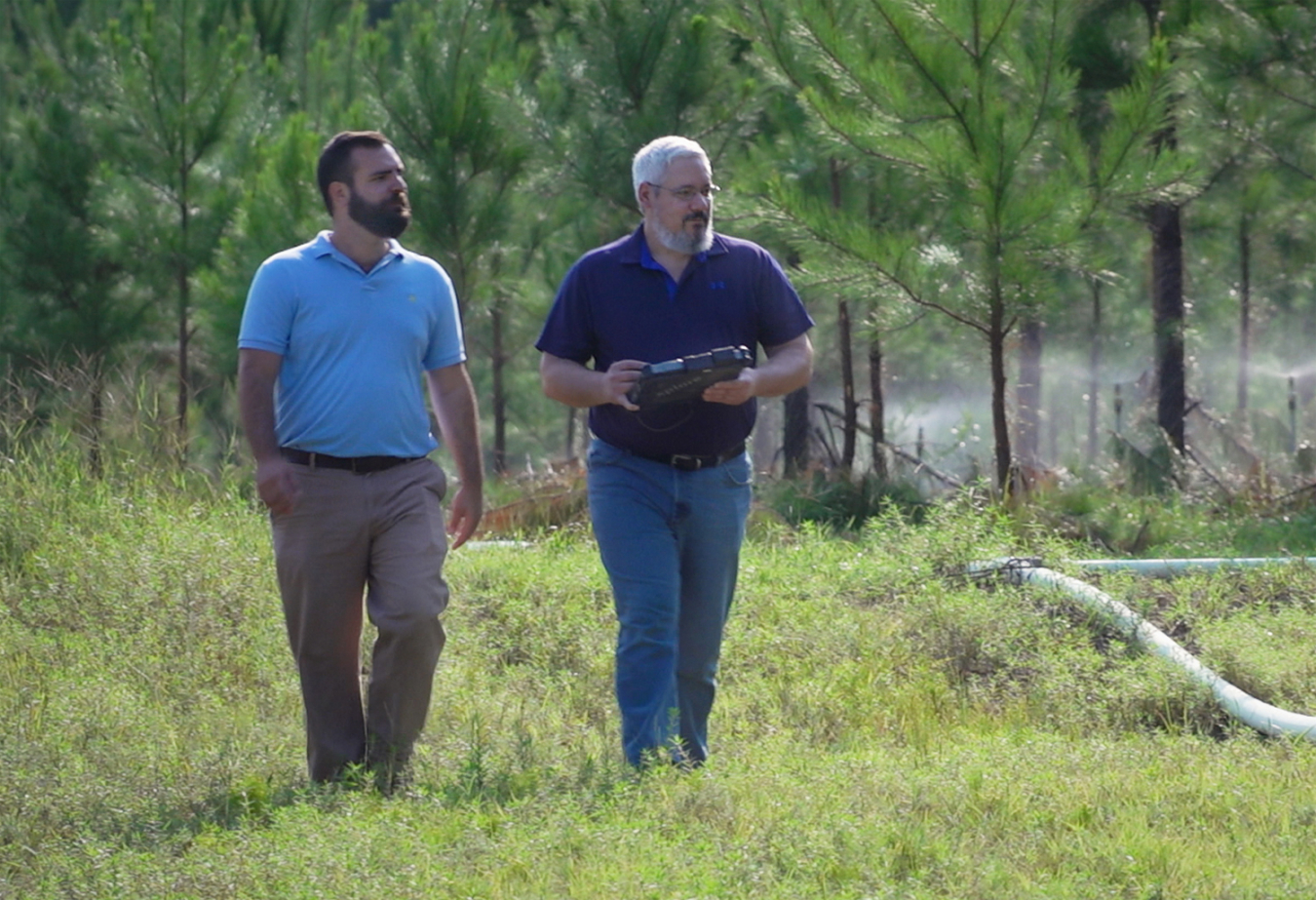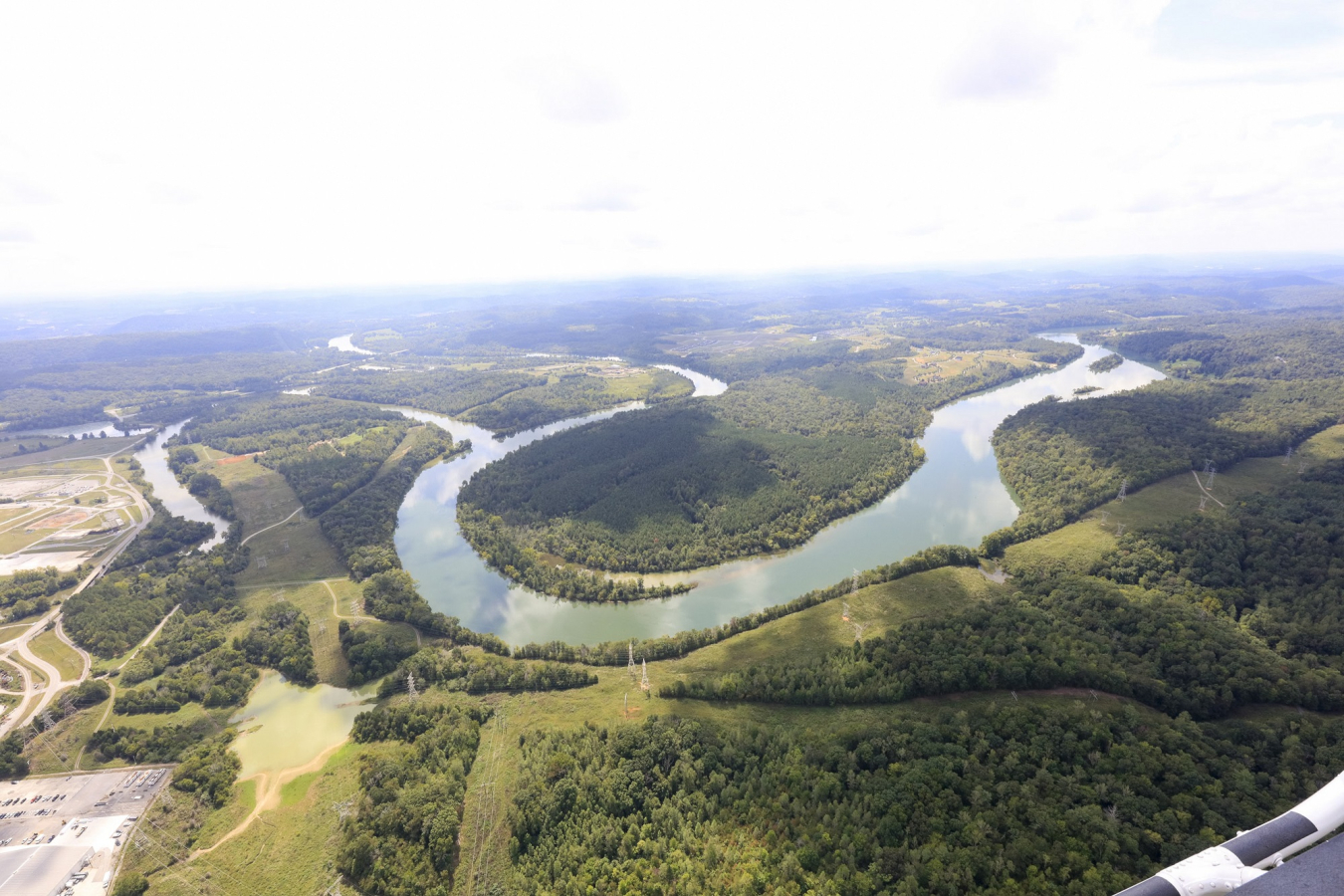
Savannah River National Laboratory Engineer Peter Avioli, left, and Jeff Thibault, an engineer with Savannah River Nuclear Solutions, inspect the Savannah River Site’s phytoremediation project. More than 60 acres of pine trees draw up irrigated water containing tritium pumped from a nearby holding pond and harmlessly release it into the atmosphere through photosynthesis.
DOE bestowed its Sustainability Award on the EM program at the Savannah River Site (SRS) last week for its innovative use of natural resources to safely address groundwater containing the legacy contaminant tritium.
SRS received the Sustainability Award in the “Innovative Approach to Sustainability” category.
"Your efforts and commitment to sustainability have been essential in ensuring DOE's continued success as a federal leader in sustainability," said Scott L. Whiteford, director of the DOE Office of Asset Management.
The Oak Ridge Office of Environmental Management (OREM) also earned an honorable mention in the awards program’s “Strategic Partnerships for Sustainability” category for its strategic cleanup successes that are leading to environmental and economic progress in East Tennessee.
In the SRS cleanup project, 62 acres of pine trees effectively act like a forest of tall hydraulic pumps. They draw up irrigated water containing tritium pumped from a nearby holding pond and harmlessly release it into the atmosphere through photosynthesis.
Since the project began in 2001, approximately 190 million gallons of water containing nearly 7,000 curies of tritium have been responsibly irrigated. This remediation method prevents contaminated groundwater from discharging into a nearby stream.
“Simply put, we reroute the contaminated water from moving towards the site boundary and, instead, use the forces of nature to safely transform and eliminate it from the site,” said Jeff Thibault, an engineer with EM contractor Savannah River Nuclear Solutions (SRNS).
Researchers and engineers from the U.S. Department of Agriculture Forest Service-Savannah River (USDA FS-SR), DOE-Savannah River (DOE-SR) and SRNS began designing the approach relying on pine trees in 1999 because “no practicable treatment technology exists to remove tritium from large volumes of groundwater,” said Philip Prater, DOE-SR senior physical scientist.
“Traditional remediation costs associated with this level of tritium removal using ‘pump, treat and reinject’ equipment would have cost close to $180 million over the last 20 years,” said Prater.
The project cost over that timeframe has been about $12 million.
SRS produced tritium for use in the manufacture of nuclear weapons from the site's inception in the early 1950s until the end of the Cold War.
“Only limited pumping is needed in support of the irrigation system, as the trees naturally provide for water uptake and evapotranspiration to the atmosphere,” said Kevin Boerstler, SRNS Area Completion Projects (ACP) subject matter expert.
The SRS project is cost effective because it doesn’t require round-the-clock operations. The contaminated groundwater also flows naturally to the surface, where it collects in the small holding pond.
At the core of the SRS project is phytoremediation, which is the use of plants to clean up a contaminated environment. The USDA FS-SR conducts this process using 51 irrigation zones. It has been largely computerized for optimal evaporation efficiency.
“This sustainable cleanup approach is effective without creating large volumes of waste,” said Prater. “Further, it’s environmentally friendly, as phytoremediation provides for an astounding carbon sequestration of 192 tons annually — an estimated offset equivalent to the use of 37 cars each year.”
The University of Georgia’s Savannah River Ecology Laboratory (SREL) conducted annual sampling and tests. They concluded that about 80% of the tritiated groundwater applied to the pine tree plot was efficiently evaporated in 2021.
That is noteworthy, Prater said, as it demonstrates how much more effective the trees are compared to mechanical evaporator systems, which are typically about 25% effective.
“Public concerns about managing contaminated water at SRS are understandable,” said Thibault. “However, test results validate that the level of tritium found within the irrigation area produces a radiation dose so low as to be insignificant. The fact is optimal water levels are being maintained in the pond. The evaporated tritium becomes virtually immeasurable beyond the irrigated section of forest, much less at the site boundary.”
The success of the ongoing project reflects the collaboration of DOE-SR, SRNS ACP, USDA FS-SR, SREL and the Savannah River National Laboratory. They also worked with the South Carolina Department of Health and Environmental Control on the project.

The Oak Ridge awards program submission, titled “Natural Partnerships - A Sustainable Legacy for the Oak Ridge Reservation,” focused on the complementary nature of DOE’s cleanup, science and research missions paired with the recreational assets and natural landscape that make Oak Ridge unique.
“Our community is extremely proud of the ongoing public and private partnerships by OREM and UCOR that are transforming the Oak Ridge Reservation and our region while advancing sustainability and natural resource management in our area,” Community Reuse Organization of East Tennessee President and CEO Teresa Frady said. “Together, we’ve proven that with planning and collaboration, cleanup can enable both economic revitalization and conservation goals.”
Those partnerships have delivered numerous accomplishments over the years, including establishment of trails and greenways across the Oak Ridge Reservation, historic preservation through the Manhattan Project National Historical Park and K-25 History Center, and the transfer of thousands of acres for conservation.
To receive the latest news and updates about the Office of Environmental Management, submit your e-mail address.
